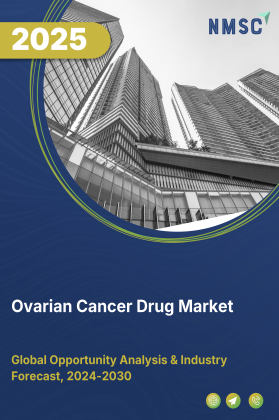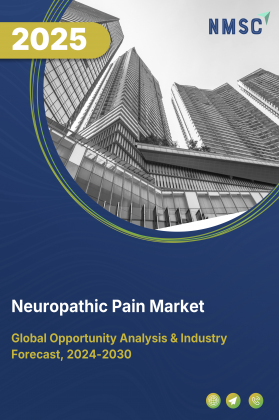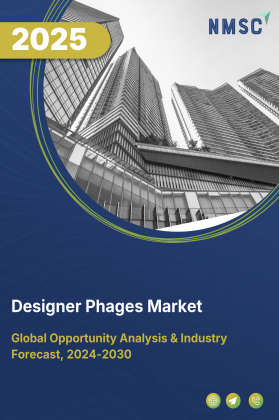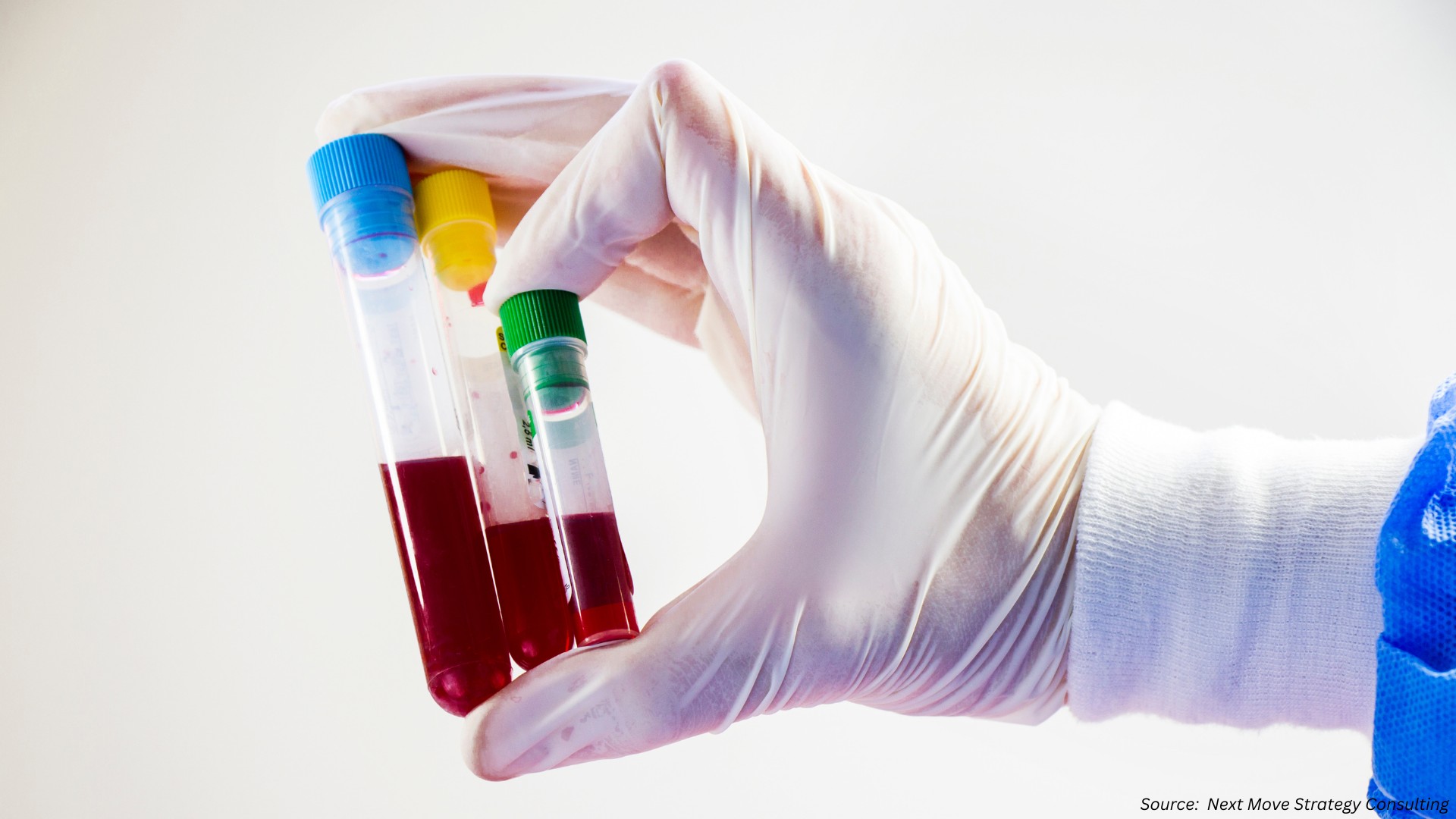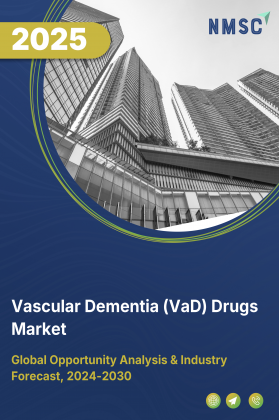
Vascular Dementia (VaD) Drugs Market by Drug Class (Cholinesterase Inhibitors, NMDA Receptor Modulators, and Others), by Formulation (Capsule, Patch, Liquid, and Injectable), by Route of Administration (Oral, Transdermal, Parenteral, Subcutaneous, and Sublingual), by Distribution Channel (Hospital Pharmacies, Retail Pharmacies, and Online), and by Application (Post-Stroke Cognitive Impairment, Mild Vascular Dementia, and Others) – Global Opportunity Analysis and Industry Forecast, 2025–2030
Industry Outlook
The global Vascular Dementia (VaD) Drugs Market size was valued at USD 2.76 billion in 2024 and is estimated to reach USD 2.9 billion in 2025 and is predicted to reach USD 3.6 billion by 2030 with a CAGR of 4.3% from 2025-2030.
The market is experiencing steady growth driven by the rising prevalence of dementia, the increasing incidence of cardiovascular diseases, and higher global healthcare expenditure. With aging populations and growing cases of Alzheimer’s disease and diabetes contributing to dementia, the demand for effective VaD therapies continues to expand.
Cardiovascular conditions such as hypertension and atherosclerosis further accelerate disease onset, fueling the need for targeted treatments. While stringent regulatory processes and high development costs remain key challenges, ongoing research into neuroprotective agents presents promising opportunities. As new therapies progress through clinical trials, the market is expected to witness significant advancements and expanded treatment options in the coming years.
Increasing Prevalence of Dementia Drives Market Growth
The rising prevalence of dementia, fueled by an aging global population, increasing incidence of Alzheimer’s disease, and the growing burden of diabetes, is significantly boosting the vascular dementia drugs market demand. According to Alzheimer’s Disease International, a new case of dementia occurs every three seconds worldwide.
In 2020, over 55 million people were living with dementia, a figure projected to nearly double to 78 million by 2030 and reach 139 million by 2050. Much of this growth is expected in developing countries, where 60% of dementia cases currently exist, a proportion anticipated to rise to 71% by 2050. This increasing disease burden directly drives the demand for effective VaD therapies.
Rising Incidence of Cardiovascular Diseases Accelerates Market Expansion
Cardiovascular diseases (CVDs), including hypertension and atherosclerosis, are key contributors to the onset of dementia care pharmaceuticals, further propelling the VaD drugs market growth. As reported by the World Health Organization (WHO), CVDs are the leading cause of death globally, claiming an estimated 17.9 million lives annually. The surge in cardiovascular conditions heightens the risk of neurodegenerative disorder, creating substantial demand for targeted therapeutic interventions and accelerating market growth.
Increasing Healthcare Expenditure Supports Market Demand
Growing healthcare spending by governments and private sectors worldwide is driving demand for advanced and improved treatments for dementia and Alzheimer’s disease. For instance, the U.S. Centers for Medicare & Medicaid Services projected an 8.2% increase in national health spending in 2024, with a further 7.1% rise expected in 2025. Such investments facilitate the adoption of new and effective VaD therapies, supporting the vascular dementia drugs market expansion.
Regulatory Challenges Restrict Market Growth
Despite the growing demand, the industry faces challenges due to the rigorous and lengthy process of obtaining regulatory approvals for new drugs. Delays in market entry and high development costs restrain growth, slowing the availability of innovative vascular dementia therapies.
Ongoing R&D of Neuroprotective Drugs Offers Future Opportunities
Continuous research and development of neuroprotective agents, including nimodipine, propentofylline, and posatirelin, presents significant opportunities for the market. These drugs are under investigation for their potential to mitigate cognitive decline in vascular dementia patients.
As they advance through clinical trials and potentially gain regulatory approval, they are expected to expand treatment options, meet growing patient needs, and further drive the vascular dementia drugs market growth.
Market Segmentation and Scope of Study
The vascular dementia drugs market report is segmented by drug class, formulation, route of administration, distribution channel, application, and region. By drug class, it includes cholinesterase inhibitors, NMDA receptor modulators, monoaminergic agents (dopaminergic, serotonergic, noradrenergic), antipsychotics (typical and atypical), antiplatelets (aspirin-based, ADP receptor inhibitors, others), anticoagulants (warfarin, DOACs, heparin & derivatives), antihypertensives (ACE inhibitors, beta-blockers, calcium channel blockers, diuretics, others), and others. By formulation, it is categorized into capsule, patch, liquid, and injectable. By route of administration, it covers oral, transdermal, parenteral, subcutaneous, and sublingual. By distribution channel, it is divided into hospital pharmacies, retail pharmacies, and e-commerce. By application, it includes post-stroke cognitive impairment, mild, moderate, severe vascular dementia, and others. Regional analysis spans North America, Europe, Asia-Pacific, and Rest of the World (RoW).
Geographical Analysis
North America currently dominates the VaD drugs market share and is expected to maintain its leadership throughout the forecast period. This dominance is driven primarily by significant investments in research and development by regional organizations, supporting the discovery of novel therapeutic approaches and the development of innovative medications.
Recently, the Alzheimer’s Association invested a record-breaking $100 million in research initiatives, including over $75 million dedicated to new scientific investigations marking the first time the organization allocated more than $100 million to research in a single year. These investments aim to accelerate global dementia research, promote early detection and risk reduction, and enhance quality care and patient support. Such robust R&D funding facilitates the development of new drugs and treatments, thereby driving the growth of the North American market.
The Asia-Pacific region is expected to experience steady growth in the market, supported by increasing healthcare expenditure and expanding healthcare infrastructure. For example, in India, public healthcare spending is projected to reach 1.9% of GDP in FY26, compared to 2.5% in FY25, as reported in the Economic Survey 2024-25 by IBEF. This rising investment in healthcare is anticipated to improve access to dementia treatments and support the adoption of advanced therapies, fueling market growth in the region.
In Europe, the rapidly aging population is expected to drive substantial demand for neurodegenerative disorder drugs. The proportion of individuals aged 80 and above is projected to increase from 6.1% in 2024 to 15.3% by 2100. This significant demographic shift is likely to elevate the prevalence of vascular dementia, creating a growing need for effective treatments and thereby contributing to the market expansion across European countries.
The Rest of the World (RoW), including Latin America, the Middle East, and Africa, is anticipated to witness gradual growth in the vascular dementia drugs market. Rising awareness of dementia, improving healthcare infrastructure, and increasing government initiatives to support elderly care are driving this growth.
For instance, countries like Brazil and Mexico are investing in healthcare programs to improve diagnosis and treatment of cognitive disorders, while the Middle East and African regions are expanding healthcare accessibility and infrastructure. Although these regions currently represent a smaller market share compared to North America and Europe, the growing population of elderly individuals and increased focus on healthcare development are expected to create new opportunities for VaD drug adoption in the coming years.
Strategic Innovations Adopted by Key Players
Key players in the vascular dementia drugs industry are driving growth through breakthrough research discoveries, innovative therapy launches, and strategic regional partnerships.
-
In June 2025, researchers at UCLA identified a key brain repair mechanism in vascular dementia involving the CD39/A3AR molecular system. A drug being trialed for psoriasis showed promise in mice, promoting repair of brain tissue and functional recovery even when administered later in disease progression.
-
In April 2025, Ever Pharma (through a partnership with Getz Healthcare Philippines) introduced Cerebrolysin, a neuropeptide therapy for cerebrovascular disorders including vascular dementia, in the Philippines.
Key Benefits
-
The report provides quantitative analysis and estimations of the industry from 2024 to 2030, which assists in identifying the prevailing vascular dementia drugs market opportunities.
-
The study comprises a deep-dive analysis of the current and future vascular dementia drugs market trends to depict prevalent investment pockets in the sector.
-
Information related to key drivers, restraints, and opportunities and their impact on the market is provided in the report.
-
Competitive analysis of the key players, along with their market share is provided in the report.
-
SWOT analysis and Porters Five Forces model is elaborated in the study.
-
Value chain analysis in the market study provides a clear picture of roles of stakeholders.
Vascular Dementia (VaD) Drugs Market Key Segments
By Drug Class
-
Cholinesterase Inhibitors
-
NMDA Receptor Modulators
-
Monoaminergic Agents
-
Dopaminergic Agents
-
Serotonergic Agents
-
Noradrenergic Agents
-
-
Antipsychotics
-
Typical (First-generation)
-
Atypical (Second-generation)
-
-
Antiplatelets
-
Aspirin-based
-
ADP Receptor Inhibitors
-
Others (e.g., glycoprotein IIb/IIIa inhibitors)
-
-
Anticoagulants
-
Warfarin
-
Direct Oral Anticoagulants (DOACs)
-
Heparin & Derivatives
-
-
Antihypertensives
-
ACE Inhibitors
-
Beta-blockers
-
Calcium Channel Blockers
-
Diuretics
-
Others
-
-
Others
By Formulation
-
Capsule
-
Patch
-
Liquid
-
Injectable
By Route of Administration
-
Oral
-
Transdermal
-
Parenteral
-
Subcutaneous
-
Sublingual
By Distribution Channel
-
Hospital Pharmacies
-
Retail Pharmacies
-
E-commerce
By Application
-
Post-Stroke Cognitive Impairment
-
Mild Vascular Dementia
-
Moderate Vascular Dementia
-
Severe Vascular Dementia
-
Others
By Region
-
North America
-
The U.S.
-
Canada
-
Mexico
-
-
Europe
-
The UK
-
Germany
-
France
-
Italy
-
Spain
-
Denmark
-
Netherlands
-
Finland
-
Sweden
-
Norway
-
Russia
-
Rest of Europe
-
-
Asia-Pacific
-
China
-
Japan
-
India
-
South Korea
-
Australia
-
Indonesia
-
Singapore
-
Taiwan
-
Thailand
-
Rest of Asia-Pacific
-
-
RoW
-
Latin America
-
Middle East
-
Africa
-
Key Players
-
Novartis AG
-
Sandoz Group AG
-
Dr. Reddy’s Laboratories Ltd.
-
EVER Neuro Pharma GmbH
-
CSPC Ouyi Pharmaceutical Co., Ltd.
-
Shineway Pharmaceutical Group Co., Ltd.
-
ProNeurogen Therapeutics
-
Eisai Co., Ltd.
-
Sun Pharmaceuticals
-
Biogen
-
Eli Lilly and Company
-
F. Hoffmann-La Roche Ltd
-
AbbVie Inc.
-
Cipla Ltd
Report Scope and Segmentation
|
Parameters |
Details |
|
Market Size in 2025 |
USD 2.9 Billion |
|
Revenue Forecast in 2030 |
USD 3.6 Billion |
|
Growth Rate |
CAGR of 4.3% from 2024 to 2030 |
|
Analysis Period |
2024–2030 |
|
Base Year Considered |
2024 |
|
Forecast Period |
2025–2030 |
|
Market Size Estimation |
Billion (USD) |
|
Growth Factors |
|
|
Countries Covered |
28 |
|
Companies Profiled |
15 |
|
Market Share |
Available for 10 companies |
|
Customization Scope |
Free customization (equivalent to up to 80 working hours of analysts) after purchase. Addition or alteration to country, regional, and segment scope. |
|
Pricing and Purchase Options |
Avail customized purchase options to meet your exact research needs. |

















 Speak to Our Analyst
Speak to Our Analyst



